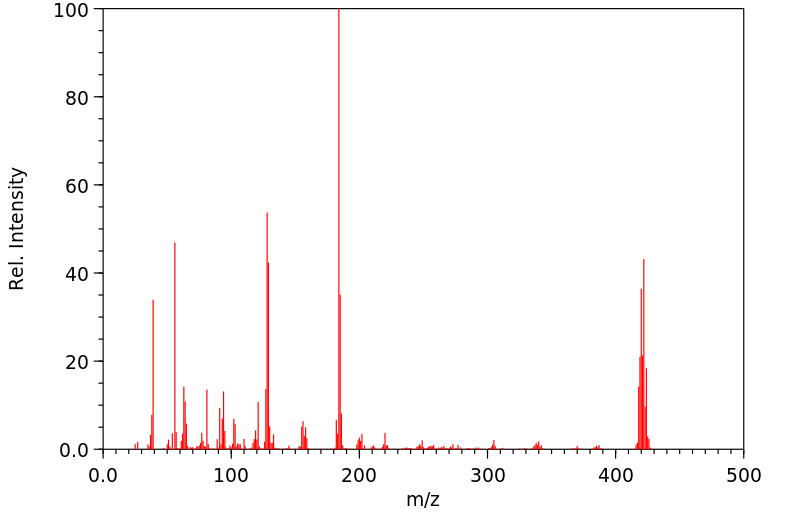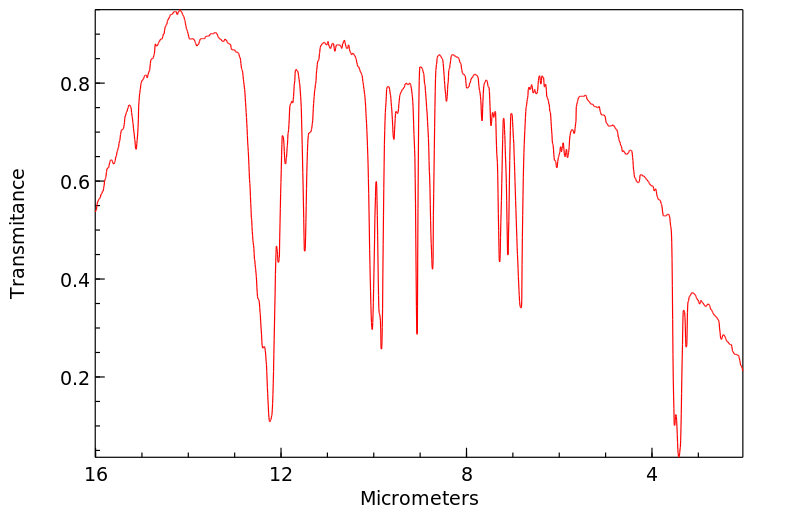1-(chloromercuri)ferrocene
中文名称
——
中文别名
——
英文名称
1-(chloromercuri)ferrocene
英文别名
ferrocenemercury(II) chloride;1-(chloromercuric)ferrocene;1-(chloromercurio)ferrocene;Ferrocenyl mercury chloride;ferrocenylmercury chloride;(chloromercurio)ferrocene
CAS
——
化学式
C10H9ClFeHg
mdl
——
分子量
421.071
InChiKey
HYMWFUMQYGKWQA-UHFFFAOYSA-M
BEILSTEIN
——
EINECS
——
-
物化性质
-
计算性质
-
ADMET
-
安全信息
-
SDS
-
制备方法与用途
-
上下游信息
-
文献信息
-
表征谱图
-
同类化合物
-
相关功能分类
-
相关结构分类
计算性质
-
辛醇/水分配系数(LogP):None
-
重原子数:None
-
可旋转键数:None
-
环数:None
-
sp3杂化的碳原子比例:None
-
拓扑面积:None
-
氢给体数:None
-
氢受体数:None
反应信息
-
作为反应物:描述:参考文献:名称:二茂铁和环戊二烯基三羰基锰的一些汞衍生物的原脱汞摘要:已经描述了二茂铁和环戊二烯基三羰基锰的一些对称和不对称汞衍生物在90%二恶烷中的质子分解。在该反应中,发现二茂铁基比p更具电子吸引力。-茴香基基团,而环戊二烯基锰-三羰基基团相对于苯基基团表现为弱受体。二茂铁基汞的原解聚反应比氯化二茂铁基汞的原解脱快约130倍,而双(环戊二烯基锰-三羰基)汞的原解速度比环戊二烯基锰-三羰基汞的原解快30倍。高铁酸对二茂铁基汞的原解汞作用约为盐酸的一半。在二苯汞的情况下,氯化钾的添加提高了高氯酸和盐酸对质子分解的反应速度。结果表明,二铁茂铁基汞和二苯基汞中的汞原子对亲核助剂的敏感性近似相等。研究了二恶烷的含水量对二茂铁基汞,双-(环戊二烯基锰-三羰基锰)汞和二苯基汞的原脱汞速率的影响。发现所有三种化合物的分解速率均随着二恶烷水含量的增加而降低。还显示出二铁茂铁基汞和双(环戊二烯基锰-三羰基)汞的原脱汞机理与二苯基汞在原理上没有区别,并且该解释不需要任何形式的金属原子参与确定反应速率的阶段。DOI:10.1016/0022-328x(68)80087-7
-
作为产物:描述:bis(ferrocenyl)mercury 以 四氯化碳 为溶剂, 以57%的产率得到1-(chloromercuri)ferrocene参考文献:名称:Nesmeyanov, A. N.; Perevalova, E. G.; Nesmeyanova, O. A., Izvestiya Akademii Nauk SSSR, Seriya Khimicheskaya, 1962, p. 40 - 44摘要:DOI:
文献信息
-
Synthesis and Structural Characterization of Monophosphine-Cyclopalladated Ferrocenylpyrimidine Complexes and Reusable Catalytic System for Amination of Hindered Aryl Chlorides in PEG-400作者:Chen Xu、Zhi-Qiang Wang、Wei-Jun Fu、Xin-Hua Lou、Ying-Fei Li、Fei-Fei Cen、Hong-Ji Ma、Bao-Ming JiDOI:10.1021/om801149r日期:2009.3.23catalytic activity of these air- and moisture-stable palladacycles was evaluated in the Buchwald−Hartwig amination involving a range of sterically hindered aryl chlorides. 5 and 6 were found to be very efficient for this reaction. Typically, using 1 mol % of catalyst in the presence of 2 equiv of KtOBu as base in PEG-400 [poly(ethylene glycol-400)] at 120 °C provided coupling products in excellent一个新的基于二茂铁-配体,4,6-二甲基-2- pyrimidinylferrocene(1),通过chloromercuriferrocene和4,6-二甲基-2-碘嘧啶的偶联反应方便地制备,且其单膦-钯化合物配合物3 - 6分别环钯反应和桥裂反应也很容易获得。这些化合物已通过1 H NMR,13 C 11 H NMR,IR,ESI-MS和元素分析。此外,它们的详细结构已经通过X射线单晶衍射确定,并且发现这些Palladacycles的晶体中存在许多类型的分子内和分子间氢键。这些空气和水分稳定的Palladacycles的催化活性在布赫瓦尔德-哈特维格胺(Buchwald-Hartwig)胺化反应中进行了评估,涉及一系列空间受阻的芳基氯化物。发现5和6对于该反应非常有效。通常,使用1摩尔%的催化剂的在2当量的K的存在吨OBU作为碱在PEG-400 [聚(乙二醇-400)]在120℃下提供偶联产物以优良产率。而且,这6/
-
Organomercutation of the carbanion derived from [M(CO)4(Ph2PCH2PPh2)] (M Cr, Mo or W). Crystal and molecular structure of [Cr(CO)4∗[Ph2PCH(HgMe)PPh2∗]]作者:Alan T. Hutton、Francois P. WewersDOI:10.1016/0022-328x(95)05431-n日期:1995.5The carbanions resulting from the deprotonation by nBuLi of compounds of the type [M(CO)4(Ph2PCH2PPh2)] (M Cr, Mo or W) are readily organomercurated by RHgCl [R e.g. Me, Et, Ph, or (C5H4)Fe(C5H5)] to give neutral complexes of the type [M(CO)4∗[Ph2PCH(HgR)PPh2∗]]. The X-ray crystal structure of the complex with M Cr and R Me has been determined, and reveals intermolecular C ··· O hydrogen bonding由[ n(n) BuLi对[M(CO)4(Ph 2 PCH 2 PPh 2)]类型的化合物(MCr,Mo或W)进行质子化而产生的碳负离子很容易被RHgCl [R Me例如Me,Et ,Ph或(C 5 H 4)Fe(C 5 H 5)]产生[M(CO)4 * * [Ph 2 PCH(HgR)PPh 2∗]]。已确定了具有MCr和RMe的配合物的X射线晶体结构,并揭示了分子间C···O氢键与羰基氧受体原子的键合作用以及羰基氧与氢之间的弱次级分子间相互作用。汞原子。
-
Organomercuric derivatives of barenes作者:L.I. Zakharkin、V.I. Bregadze、O.Yu. OkhlobystinDOI:10.1016/s0022-328x(00)88731-8日期:1966.9(1) Organomercuric derivatives of barenes react with electrophilic reagents (e.g. hydrogen chloride, bromine, mercuric chloride), if at all only under very vigorous conditions.
-
Metal polypyrazolylborates作者:G Gioia Lobbia、C Santini、F Giordano、P Cecchi、K CoacciDOI:10.1016/s0022-328x(97)00485-3日期:1998.2X-ray crystal structure of the complex Et–Hg·TpPh2, which is here reported, represents the first case in which the Hg (bonded to an organic R-group and a tripodal N-donor ligand) is tetrahedrally coordinated (with some distortions), instead of being T-shaped. The compound is orthorhombic, space group P 212121 with a=12.966(3) Å, b=16.940(3) Å, and c=18.412(4) Å; V=4044(1) Å3; Z=4; R(Rw)=0.056(0.057).R–Hg +离子(R = Me,Et,Pr,i -Pr,Ph,p- Tol,苄基,5-Me-噻吩基或二茂铁基)配合物Tp Ph 2(hydrtritris( 3,5-二苯基-1- ħ吡唑-1-基)borato)或TP 4BR(氢化三(4-溴-1- ħ吡唑-1-基)borato)这里报告。通过1 H,13 C和199 Hg NMR光谱的比较显示,配体Tp Ph 2比Tp 4Br更好。Et–Hg·Tp Ph 2复合物的X射线晶体结构此处报道的,是第一种情况,其中Hg(结合到有机R-基团和三脚架N-供体配体上)四面体配位(有些变形),而不是T形。该化合物是正交晶体,空间群P 2 1 2 1 2 1 1,其中a = 12.966(3)Å,b = 16.940(3)Å,c = 18.412(4)Å;V = 4044(1)埃3 ; Z = 4;R(R w)= 0.056(0.057)。
-
Heterometallic Osmium−Mercury Chain Structures Linking Two {Os<sub>3</sub>(CO)<sub>10</sub>(μ-X)} Subunits (X = Cl, Br, I): Syntheses and Molecular Structures of [{Os<sub>3</sub>(CO)<sub>10</sub>(μ-X)}<sub>2</sub>(μ<sub>4</sub>-Hg)] (X = Cl, I), [{Os<sub>3</sub>(CO)<sub>10</sub>(μ-Cl)}<sub>2</sub>{μ-HgOs(CO)<sub>4</sub>}<sub>2</sub>], and <i>cis</i>-[Os(CO)<sub>4</sub>{(μ-Hg)Os<sub>3</sub>(CO)<sub>10</sub>(μ-Cl)}<sub>2</sub>]作者:Yat-Kun Au、Wing-Tak WongDOI:10.1021/ic961092p日期:1997.5.1"Hg-Os(CO)(4)}(2)-Hg" molecular backbone with the two Os(CO)(4) fragments arranged in a staggered conformation. Cluster 2a is thermally unstable and converts slowly to cis-[Os(CO)(4)(&mgr;-Hg)Os(3)(CO)(10)(&mgr;-Cl)}(2)] (4a) via the extrusion of an Os(CO)(4) moiety under ambient conditions. Cluster 4a comprises two (&mgr;-Hg)Os(3)(CO)(10)(&mgr;-Cl)} subcluster units bonded to a central Os(CO)(4)用活化簇[Os(3)(CO)(10)(NCMe)(2)]处理RHgCl(R = Me,Et,Ph,Fc)产生the-汞混合金属簇[Os(3 )(CO)(10)(&mgr; -Cl)}(2)(&mgr;(4)-Hg)](1a)和[Os(3)(CO)(10)(&mgr; -Cl)} (2)&mgr; -HgOs(CO)(4)}(2)](2a)低产量。团簇1a带有中心翼尖汞原子,同时桥接两个Os(3)(CO)(10)(&mgr--Cl)}单元。簇2a包含一个前所未有的十核de汞框架,其中有一个中心线性“ Hg- Os(CO)(4)}(2)-Hg”分子主链,两个Os(CO)(4)片段排列在交错的构型。簇2a是热不稳定的,缓慢转化为顺式-[Os(CO)(4)(&mgr; -Hg)Os(3)(CO)(10)(&mgr; -Cl)}(2)](4a)通过在环境条件下挤出Os(CO)(4)部分。群集4a包含两个(&mgr;
表征谱图
-
氢谱1HNMR
-
质谱MS
-
碳谱13CNMR
-
红外IR
-
拉曼Raman
-
峰位数据
-
峰位匹配
-
表征信息
同类化合物
高密聚乙烯
香叶醇
顺式3-甲基-2-己烯
顺式-5-癸烯
顺式-5-甲基-2-己烯
顺式-5-庚烯-1-炔
顺式-4-癸烷
顺式-4-甲基-2-戊烯
顺式-4-甲基-2-戊烯
顺式-3-癸烯
顺式-3-甲基-3-己烯
顺式-3-甲基-2-庚烯
顺式-3-戊烯-1-炔
顺式-3,4-二甲基-3-己烯
顺式-3,4-二甲基-2-戊烯
顺式-3,4-二甲基-2-戊烯
顺式-2-甲基-3-己烯
顺式-2-壬烯
顺式-2-丁烯-D1
顺式-1.1.1-三甲基-2-丁烯
顺式-1-甲基-2-环丙基乙烯
顺式-1-甲基-2-乙烯基环戊烷
顺式-1-环戊基-1-辛烯
顺式-1-氘代-3-甲基-1-丁烯
顺式-(9ci)-2,3,3a,7a-四氢-4-(1-甲基乙基)-1H-茚
顺式-(2-丁烯基)环丙烷
顺式,顺式-2,4-己二烯
顺-环辛烯
顺-9-二十一碳烯
顺-6-十三碳烯
顺-5-甲基-1,3,6-庚三烯
顺-4-辛烯
顺-4-壬烯
顺-3-辛烯
顺-3-甲基-2-戊烯
顺-3-壬烯
顺-3-十三碳烯
顺-2-辛烯
顺-2-癸烯
顺-2-戊烯
顺-2-庚烯
顺-2-己烯
顺-2-丁烯
顺-2,2-二甲基-3-己烯
顺-1,3-戊二烯
顺,顺-1,9-环十六烷二烯
顺,顺,顺-环癸-1,3,5-三烯
间戊二烯
间二(4-吡啶基)苯
镁,二-2-丁烯基-








